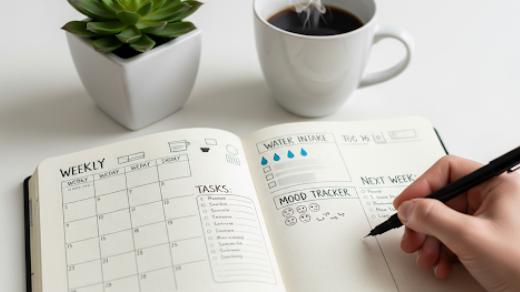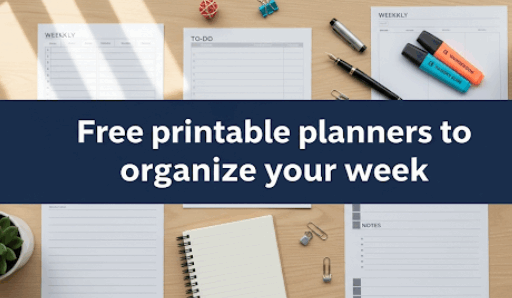Your Bullet Journal Starter Guide and Ideas For Beginners to Get Organized
I know that idea can be overwhelming when you’re drowning in to-do lists, sticky notes, and digital reminders everywhere. And if you are fed up with trying to manage multiple apps and losing track of that one thing that was really important, then perhaps bullet journaling is the answer for you. This easy and potent method of combining planning, tracking, and reflection in a single notebook brings order to the chaos.
For students working through assignments, a professional with deadlines or just somebody who wants to feel more on top of things, bullet journaling provides a solution that is flexible enough to fit around your life. The best part? You can start even if you don’t have expensive graphic supplies or professional skills.
Why Bullet Journaling is Ideal For Organizing
This is what makes bullet journaling different from other planning methods – it’s just as unique as the person making it. Your bullet journal is a living organism, nothing like a rigid pre-made planner that merely scratches the surface. Founded by Ryder Carroll, you make only as many pages as you need and only track what matters to you and tweak the system as your life changes.
This is achieved through a basic symbol system of bullets and dashes mixed with symbols that can be used to capture and sort information as you run through the tasks and projects on your plate. The brainchild of designer Ryder Carroll, this journaling system turns any notebook into a productivity powerhouse — calendar, task list, note-taking tool and personal tracker all grouped together in one place.
Essential Supplies You ACTUALLY Need To Begin
The Notebook
It makes the difference in what your bullet journal becomes. What to look for if you are a beginner?
Dot Grid Paper: Of course, the bullet journal’s gold standard is dot grid paper. Dots give you just a hint of how to write straight and draw lines, without interfering the way lined paper does.
A5 is the perfect size: Around 5.5 x 8.5 inches, big enough to write comfortably and small enough to fit in your bag or purse. The size is just right for carrying around, and still big enough to plan out all of the fine details.
Page Count: Generally around 160-240 pages per notebook. It allows you enough room for a few months before it gets too thick or too heavy to carry.
Quality Paper: Select a paper that can handle your pen of choice without bleeding through. There are a lot of options (Leuchtturm1917, Moleskine, Rhodia…)
Writing Tools
Concentrate on these bare necessities:
- Black Gel Pen: I reserve black gel pens for daily journaling and most basic bullets
- Fine Tip Markers: 2-3 colors for headings and highlighting
- Straight Edge: To make lines and alignments
- Pencil: You may also need to erase when drawing the initial sketches and layouts
Basic Bullet Journal System: Core Elements
Key Symbols and Bullets
General Symbols used in Bullet Journal System:
| Symbol | Purpose | Example |
|---|---|---|
| • | Task | Buy groceries |
| – | Note | Meeting at 3 PM |
| ○ | Event | Birthday party Sunday! |
| ! | Important | Doctor appointment |
| * | Priority | Submit report by Friday |
| × | Complete | Insurance company |
| > | Migrate | Presentation |
| < | Schedule | Dentist appointment next week |
The Four Core Collections
Index Page
It helps you discover individual pages faster and more easily, behaving like a table of contents in a book. Number your pages and note collection entries down here.
Future Log
This 6-month snapshot includes events and tasks that do not pertain to your current month. Start with the names of the months across a grid, and place items as they come up.
Monthly Log
A monthly spread consisting of a calendar page and tasks to achieve in your month.
Daily Log
Daily pages record tasks, events and notes as they occur. Label entries with your bullet symbols and date each page.
Beginner-Friendly Layout Ideas
Simple Weekly Spread
Begin with a traditional weekly layout where you can plan ahead seven days across two pages:
- Left Page: Monday, Tuesday, Wednesday with room for tasks and notes
- Right Page: Thursday, Friday, Saturday, Sunday with similar space
Then include a couple of simple habit trackers to monitor your daily goals such as water intake or exercise.
Monthly Calendar Grid
Create a classic calendar grid for every month. This will provide you with an overview of timelines and milestones in visual form. Color-code your different activities for clarity:
- Blue for work/school
- Green for personal appointments
- Red for deadlines
- Purple for social events
Goal Setting Pages
Write down your goals on one page each month:
This Month I Will:
- Complete three work projects
- Exercise 12 times
- Read two books
- Cook dinner at home 15 times
Those tasks that seem both too far away to possibly complete AND impossible to execute can be broken down into smaller and more manageable steps so they feel doable on a day-to-day basis.
Essential Tracking Pages for Organization
Habit Tracker
Use a habit tracker to form positive routines and break bad ones. A simple grid with habits listed down the left-hand side and dates depicted across the top. Fill in squares for habits completed.
Popular Habits to Track:
- Water intake (8 glasses daily)
- Exercise or movement
- Reading time
- Sleep hours
- Meditation
- Social media limits
- Healthy meals
Expense Tracker
A basic expense log to track your spending:
| Date | Category | Description | Amount |
|---|---|---|---|
| 3/1 | Food | Lunch Out | $12.50 |
| 3/1 | Transport | Gas | $35.00 |
| 3/2 | Entertainment | Movie Tickets | $24.00 |
Meal Planning Spread
Use a weekly meal planner for meal prepping and grocery shopping.
Week of March 1-7
- Monday: Spaghetti and marinara, side salad
- Tuesday: Chicken stir-fry with rice
- Wednesday: Leftover stir-fry
- Thursday: Taco Thursday
- Friday: Pizza night
- Saturday: Grilled salmon, roasted vegetables
- Sunday: Prep meals for the coming week
On the opposite page, plan a grocery list from your meal plans.
Productivity-Boosting Collections
Brain Dump Pages
Brain dump page: For when your mind is too cloudy. List out every last little thing flying around in your head with no structure or order of importance. This frees up mental bandwidth and allows you to focus on what really matters.
Take your dump and then:
- Add vital stuff to relevant daily logs
- Scratch off things that are not really important
- Add future tasks to next steps
Project Planning Spreads
For larger projects, use 2-4 pages for planning and tracking progress:
Project: Bedroom facelift
Due Date: May 1st
Budget: $500
Tasks:
- Research paint colors
- Measure room dimensions
- Shop for bedding
- Buy paint supplies
- Paint walls
- Rearrange furniture
- Add decorative touches
Keep it simple, checking off the box when accomplished or updating timelines where needed.
Reading List and Books Log
Track reading goals and discoveries for book lovers.
Books to Read This Year:
- The Seven Husbands of Evelyn Hugo
- Atomic Habits
- Where the Crawdads Sing
- The Thursday Murder Club
Books Completed:
- January: The Midnight Library – 4 out of 5 stars
- February: Educated – 5/5 stars
Time Management Techniques
Time Blocking Method
Put your daily pages to use by way of time blocking and allocate specific tasks to specific time slots.
Tuesday, March 5
- 9:00 AM – 10:30 AM: Email and admin work
- 10:30-12:00 PM: Project presentation work
- 12:00-1:00 PM: Lunch break
- 1:00-3:00 PM: Client meetings
- 3:00-4:00 PM: Research for tomorrow’s presentation
- 4:00-5:00 PM: Wind down and next-day planning
Priority Matrix
Create a basic priority matrix to accomplish the most significant things first:
- High Priority, Urgent: Do first
- High Priority, Not Urgent: Schedule
- Low Priority, Urgent: Delegate if you can
- Low Priority, Not Urgent: Delete
Weekly Review Process
End each week with a recap page:
- What went well this week?
- What challenges did I face?
- What do I need to get done next week?
- How can I improve my system?

Common Beginner Mistakes to Avoid
Perfectionism Trap
Your bullet journal doesn’t need to look like artwork. Focus on function over form. Messy writing and scribbling are as useful as anything else.
Overcomplicating the System
Start with the basics and then complicate as you go. Do not attempt to track everything under the sun all at once as some of these spreads can take hours to update.
Inconsistent Use
Build the habit slowly. Spending just five minutes of bullet journaling every day helps to create momentum. Just because you missed a day or two, that doesn’t mean you should throw the whole system in the trash.
Copying Others’ Layouts Exactly
What works for someone else may not work the same for you. Use another person to get a basic idea from but make it your own.
Making Your System Stick
Start Small
Just start with the core collections for now: index, future log, monthly log, daily log. Once these are a part of your routine then add other elements.
Set Up Success Triggers
- Store your bullet journal and pen in the same spot everyday
- Associate bullet journaling with your morning coffee routine
Regular Migration
At the end of every month, carry over undone tasks to your new monthly log. This allows you to update your system and start determining what matters.
Flexibility is Key
Your system should be serving you and not the other way around. Try something new, adapt it. One of the many reasons bullet journaling is so awesome – it’s flexible!
Advanced Strategies for Scaling Your Practice
Color Coding Systems
Establish life area color codes:
- Work/school tasks in blue
- Personal tasks in green
- Health appointments in red
- Social events in purple
Digital Integration
Although bullet journals are analog you can make them work with digital tools:
- Snap pictures of vital pages for backup
- Set up phone reminders for tasks you wrote in your journal
- Sync monthly calendar to monthly log
Seasonal Collections
Have exclusive collections for different times of the year:
- Back-to-school planning in August
- Holiday gift lists in December
- Spring cleaning checklists in March
- Summer vacation planning in May
Troubleshooting Common Challenges
“I Don’t Have Time”
It may take nothing but 5 minutes per day. Before going to sleep, write the top three tasks for tomorrow. This simple line of planning will start gathering thoughts together for more defined planning.
“My Handwriting is Terrible”
Neat handwriting isn’t required. Focus on legibility for yourself. If cursive seems messy, then print in block letters.
“I Keep Forgetting to Use It”
Put your journal somewhere that you will see it often! Set phone reminders for the first couple of weeks until it turns into a habit automatically.
“It’s Not Working”
Give it at least 3 weeks before making any calls on whether the system is working for you. If not, identify what issues you are having, and make the necessary changes.
Your Path to Improved Organization Begins Today
Using a bullet journal can be a huge step toward better organization, but remember — the best system is one you actually use consistently. Begin with the foundations outlined in this guide, try out various formats and tracking methods, and organically create a system that benefits your life.
Start slow, and your practice will develop from there. Don’t worry about having the perfect system from day one. Instead, focus on getting everything out of your head and capturing it in one trusted location. When you are getting the hang of it, you can determine which disciplines best fit your lifestyle and needs.
Your bullet journal is a mirror of your life, how you spend your time, and what matters to you. As the use becomes more common, you are not only getting organization skills but also some invaluable insights into how you operate and where you want to be in the months/years from now. Remember that just getting things out of your head and onto paper significantly clears up the mental clutter and allows your mind to focus on what is important.
It doesn’t matter whether you are managing school assignments, work projects, household tasks or personal goals; using a bullet journal will help you keep everything organized while also being flexible enough to handle it all. Try it out today with nothing but a notebook and pen, and see how this straightforward system can change the way you approach organization in your life. Your future, more put-together self will thank you.




